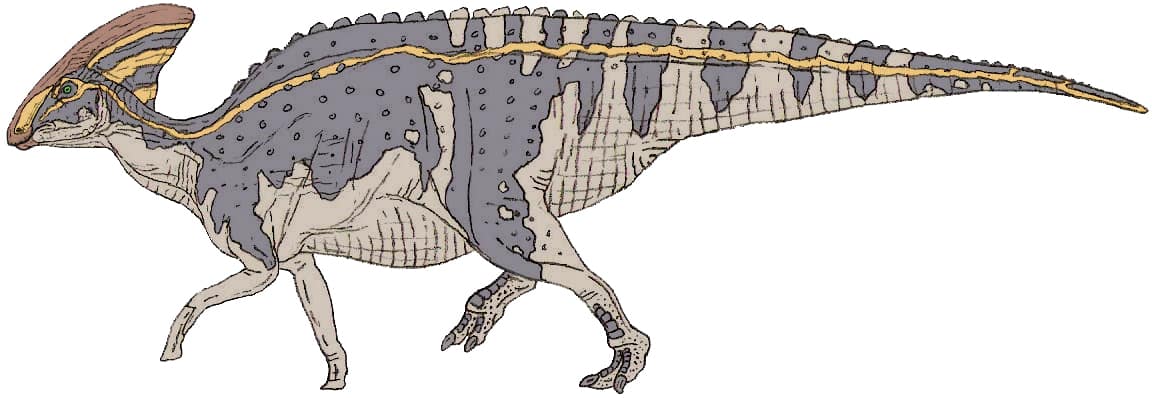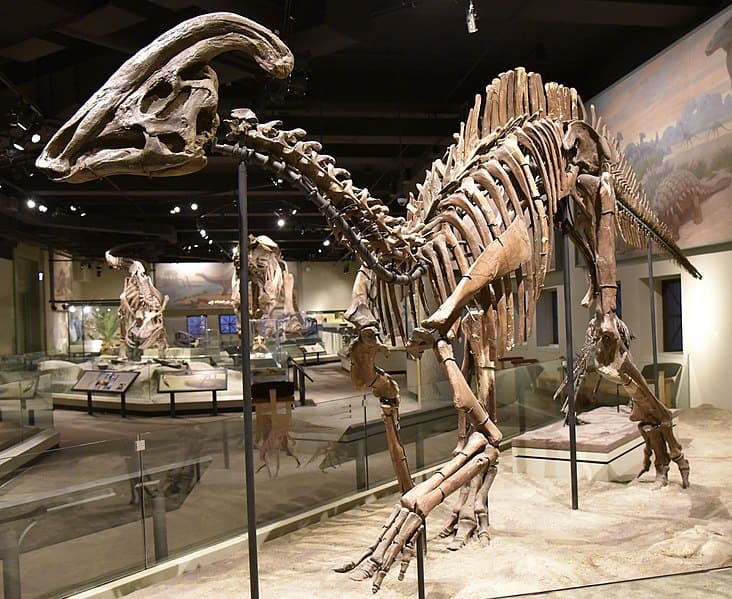
Parasaurolophus is probably the most interesting dinosaur you’ve never heard about. This herbivore dinosaur lived during the Cretaceous and could walk on both four legs and two legs. But that’s not even the most interesting about it. The Parasaurolophus had a spectacular crest on its head. This crest was used for multiple things, including sound generation and amplification.
A Dinosaur That Sings?
You may have heard of the T-Rex or the Velociraptor, but have you ever heard of the Parasaurolophus? This fascinating dinosaur, pronounced pa-RAS-or-OL-uh-fus, roamed the Earth during the Late Cretaceous period from 76.5 to 73 million years ago. For comparison, the T-Rex lived about 66–68 million years ago.
Parasaurolophus isn’t a single dinosaur, it’s actually a genus — or a group of dinosaurs. This genus includes three species (at least three that we’ve found so far). There’s another fourth species that’s debated. However, most researchers usually place that in another group.
The dinosaur was a part of a group called Hadrosaurids, or duck-billed dinosaurs. In fact, Parasaurolophus also had a duck bill and a pretty complex skull. But its most notable feature was definitely the crest.
The Crest: A Musical Instrument?
Picture a dinosaur with a large, tube-like crest extending from its skull. This crest is the defining feature of the Parasaurolophus. It resembles an old wind instrument, doesn’t it?
Well… that’s sort of what it is. Kind of.
“Over the past 100 years, ideas for the purpose of the exaggerated tube crest have ranged from snorkels to super sniffers,” noted David Evans, the Temerty Chair in Vertebrate Palaeontology and Vice President of Natural History at the Royal Ontario Museum, and author of a recent study on this dinosaur.
“But after decades of study, we now think these crests functioned primarily as sound resonators and visual displays used to communicate within their own species.”

The duckbilled Parasaurolophus sported an elongate, tube-like crest on its head. This wasn’t hollow — it contained a complex internal network of airways.
“Imagine your nose growing up your face, three feet behind your head, then turning around to attach above your eyes. Parasaurolophus breathed through eight feet of pipe before oxygen ever reached its head,” said Terry Gates, a paleontologist from North Carolina State University, co-author of the research.
A recently discovered skull belonging to Parasaurolophus cyrtocristatus (or P. cyrtocristatus) showed remarkable conservation, enabling a better understanding of its unique features.
“The preservation of this new skull is spectacular, finally revealing in detail the bones that make up the crest of this amazing dinosaur known by nearly every dinosaur-obsessed kid,” said Joe Sertich, curator of dinosaurs at the Denver Museum of Nature & Science and the leader of the team. “This just reinforces the importance of protecting our public lands for scientific discoveries.”
“My jaw dropped when I first saw the fossil,” said Gates. He continued, “I’ve been waiting for nearly 20 years to see a specimen of this quality.”
“This specimen is truly remarkable in its preservation,” said Evans, who has also worked on this iconic dinosaur for almost two decades. “It has answered long-standing questions about how the crest is constructed and about the validity of this particular species. For me, this fossil is very exciting.”
Thanks to fossils like this, and the careful analysis performed by paleontologists, we have a much better understanding of this crest. It could have served various functions, ranging from sound amplification for communication to visual display for identifying species and sex.
Although there’s still some speculation, researchers believe the crest’s primary role would have been to generate sound resonance, enabling the dinosaur to communicate across vast distances. Imagine a herd of Parasaurolophus “singing” to each other across a prehistoric valley — that’s quite the concerto.

Habitat and Diet: What Did Parasaurolophus Eat?
You wander through the lush forests and swamps of what is now North America. We’re talking about a period when there was almost no ice at the poles and lush vegetation covered much of the land. The dominant vegetation of this period consisted of flowering plants (angiosperms) which had begun to diversify. Conifers, ferns, and cycads were also abundant. The widespread presence of these plants indicates that there was a variety of terrestrial habitats, from dense forests to open plains.
Parasaurolophus would have mostly grazed on plants such as ferns and cycads.
With a beak-like mouth and strong teeth, this herbivore could easily chew tough vegetation from the ground up to a height of around 4 m. A peaceful grazer, Parasaurolophus likely spent most of its time eating and looking out for predators.
Parasaurolophus was both a bipedal and quadrupedal herbivore dinosaur. It ate plants with a sophisticated skull that permitted a grinding motion similar to chewing. The dinosaur had teeth packed into dental batteries. These batteries contained hundreds of teeth, and the teeth were continually replaced.
What Did Parasaurolophus Look Like? A Graceful Giant

The Parasaurolophus was a striking creature. Standing on two legs, it had a graceful, balanced posture. Its body was covered in scales, and it sported a long tail.
Like most dinosaurs, Parasaurolophus hides many mysteries. Researchers have only found partial fossils. This means that researchers have to infer some of its characteristics — they didn’t directly observe them. As such, its physical characteristics are estimated from the incomplete fossils we do have.
The length of the type specimen of P. walkeri is estimated at 11.45 m (37.6 ft) and its weight is estimated at 2.47 metric tons.
Its skull alone would have been about 1.6 m (5 ft 3 in) long, including the crest. However, one species, P. tubicen would have had a skull size over 2 m (6 ft 7 in) long, indicating it was a larger animal.
We also don’t know that much about what colors this dinosaur would have sported but usually, the Parasaurolophus was depicted as a mostly green or grey type of dinosaur.
Paleontological Discoveries
Put on your paleontologist’s hat, and let’s dig into the past. The first Parasaurolophus fossil was discovered in 1920 near Sand Creek along the Red Deer River in Alberta. Since the discovery of the first Parasaurolophus fossil, scientists have been piecing together the life of this enigmatic creature.
Researchers have found fossils in Utah, New Mexico, and Alberta, Canada. Each discovery adds another piece to the puzzle, helping us to understand the life and times of this unique dinosaur.

Thanks to such fossils, we know for instance that some Parasaurolophus shared its paleoenvironment with other dinosaurs, such as dromaeosaurid theropods. It lived in a period alongside marine creatures (like sharks and rays), amphibians (like frogs and salamanders), and reptiles like turtles, lizards, and crocodilians. A variety of early mammals were present including multituberculates, marsupials, and insectivorans.
Parasaurolophus FAQ
Parasaurolophus is a genus of herbivorous ornithopod dinosaur that lived during the Late Cretaceous period, around 76.5 to 73 million years ago.
It’s pronounced pa-RAS-or-OL-uh-fus.
The most notable feature of Parasaurolophus is its long, tube-like crest extending from the back of its skull.
Researchers believe the crest primarily served as a sound resonator and a visual display. It might have helped in communication within their species and possibly in identifying species and sex.
Fossils have been discovered in places like Utah, New Mexico in the USA, and Alberta in Canada.
Parasaurolophus was an herbivore. It mostly grazed on plants such as ferns and cycads.
Different species vary in size, but the type specimen of P. walkeri is estimated at 11.45 m (37.6 ft) in length, and its weight is estimated at 2.47 metric tons.
It was both bipedal and quadrupedal, meaning it could walk on either two or four legs.
Yes, the genus Parasaurolophus includes at least three species. However, there is a debated fourth species which most researchers typically classify in another group.
The name Parasaurolophus is derived from the Greek words, meaning “near crested lizard”.
Yes, Parasaurolophus was part of the Hadrosaurids, or duck-billed dinosaurs. There are other members of this family, although Parasaurolophus is particularly noted for its distinctive crest.
Conclusion: We’ve learned a lot, but Parasaurolophus is still an Enduring Mystery
The Parasaurolophus offers a glimpse into a world vastly different from our own. It’s a dinosaur that has intrigued and inspired many, not just because of its striking crest but also because it embodies the sheer diversity of prehistoric life. This hadrosaurid, with its potential to communicate through vast expanses and its grandeur in size, brings forth a mix of awe and wonder. The fossils, both old and newly discovered, are a testament to nature’s ability to adapt, evolve, and flourish in myriad environments.
As we peer into the relics of this Cretaceous-era giant, we’re reminded of the countless amazing creatures that our planet once held – a revelation that continues to surprise and educate us. So, next time you think of the mighty T-Rex or the agile Velociraptor, spare a thought for the melodious Parasaurolophus. Amidst the roaring and thundering of the prehistoric world, it might just have played the sweetest note.


